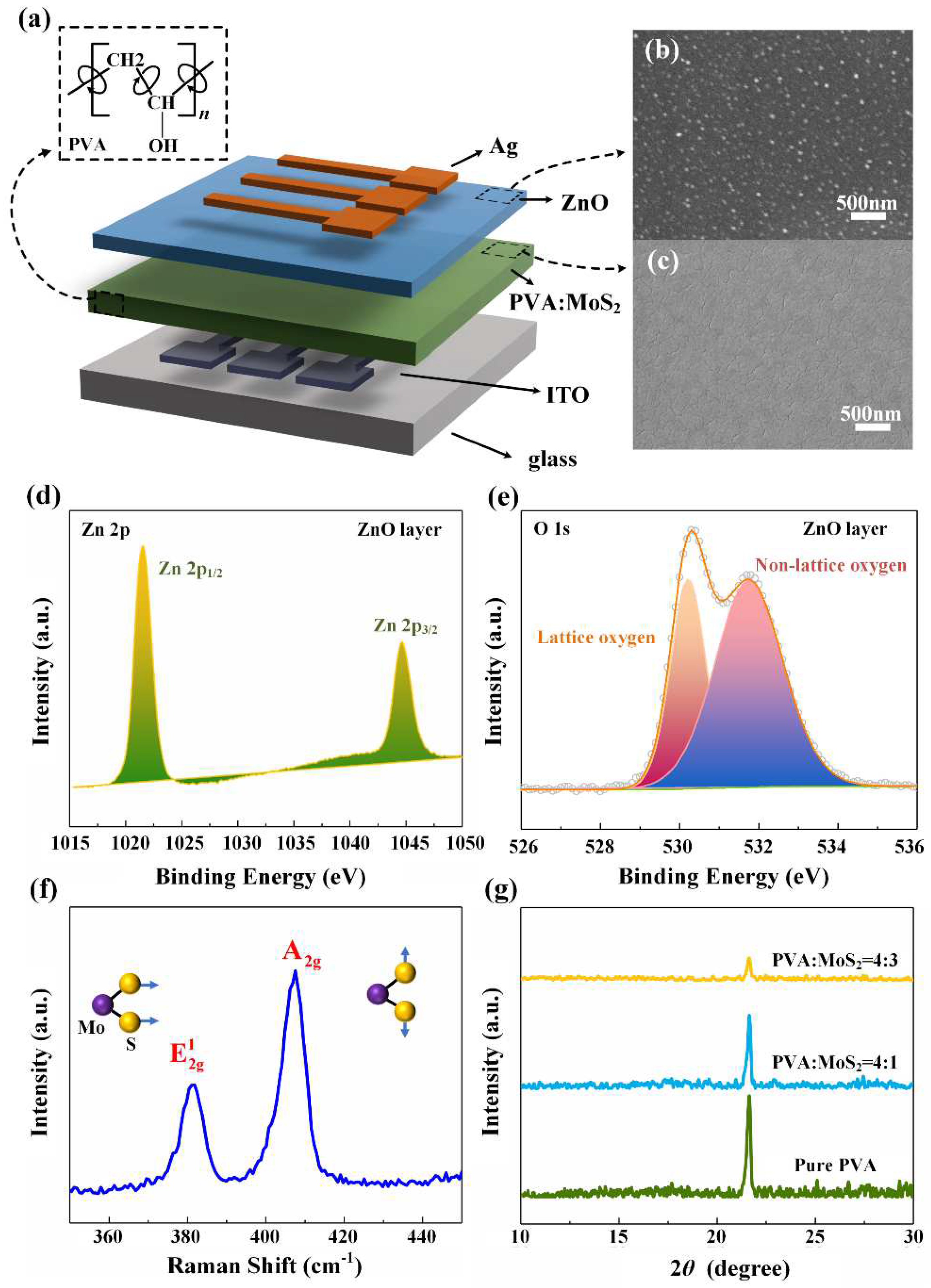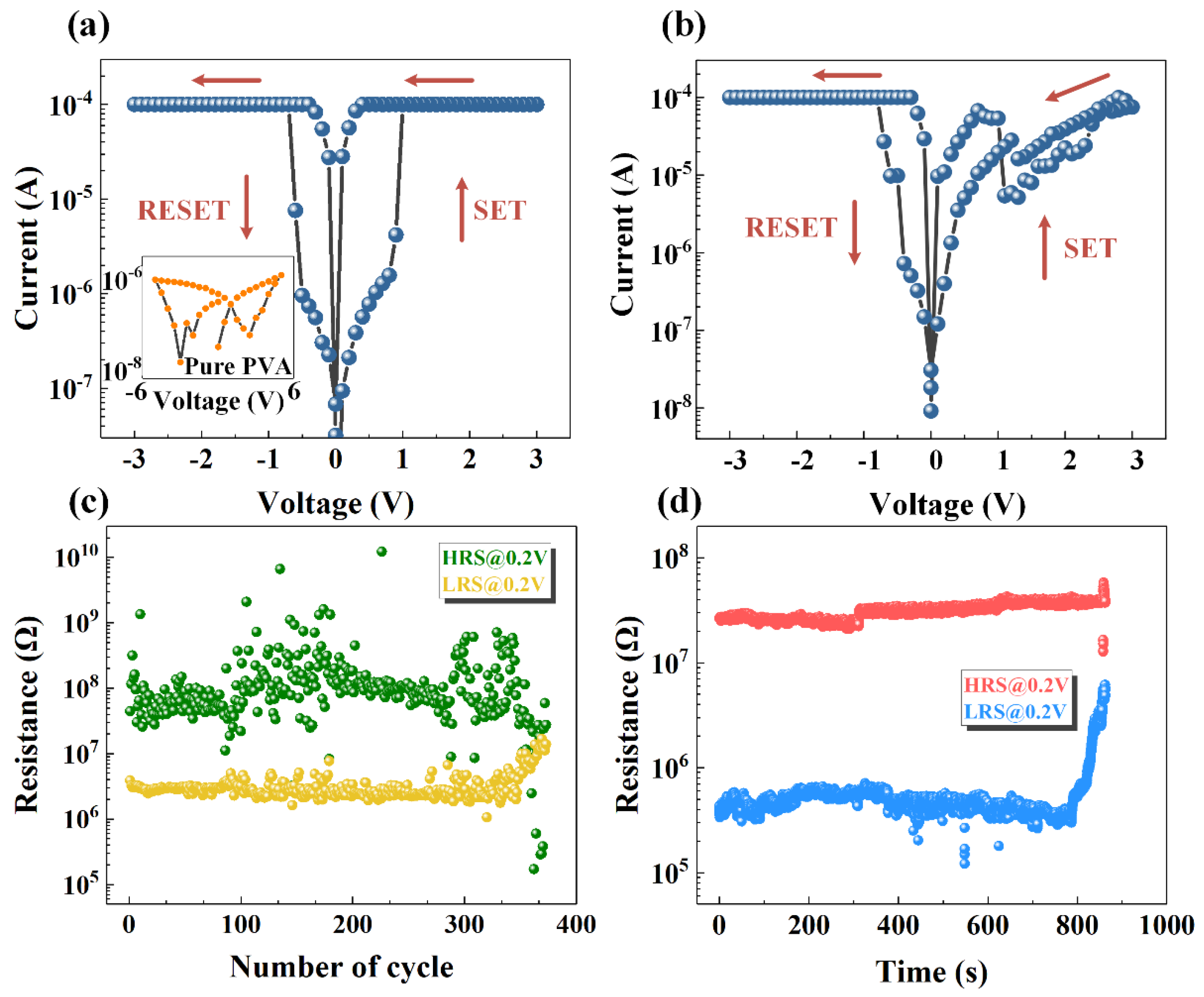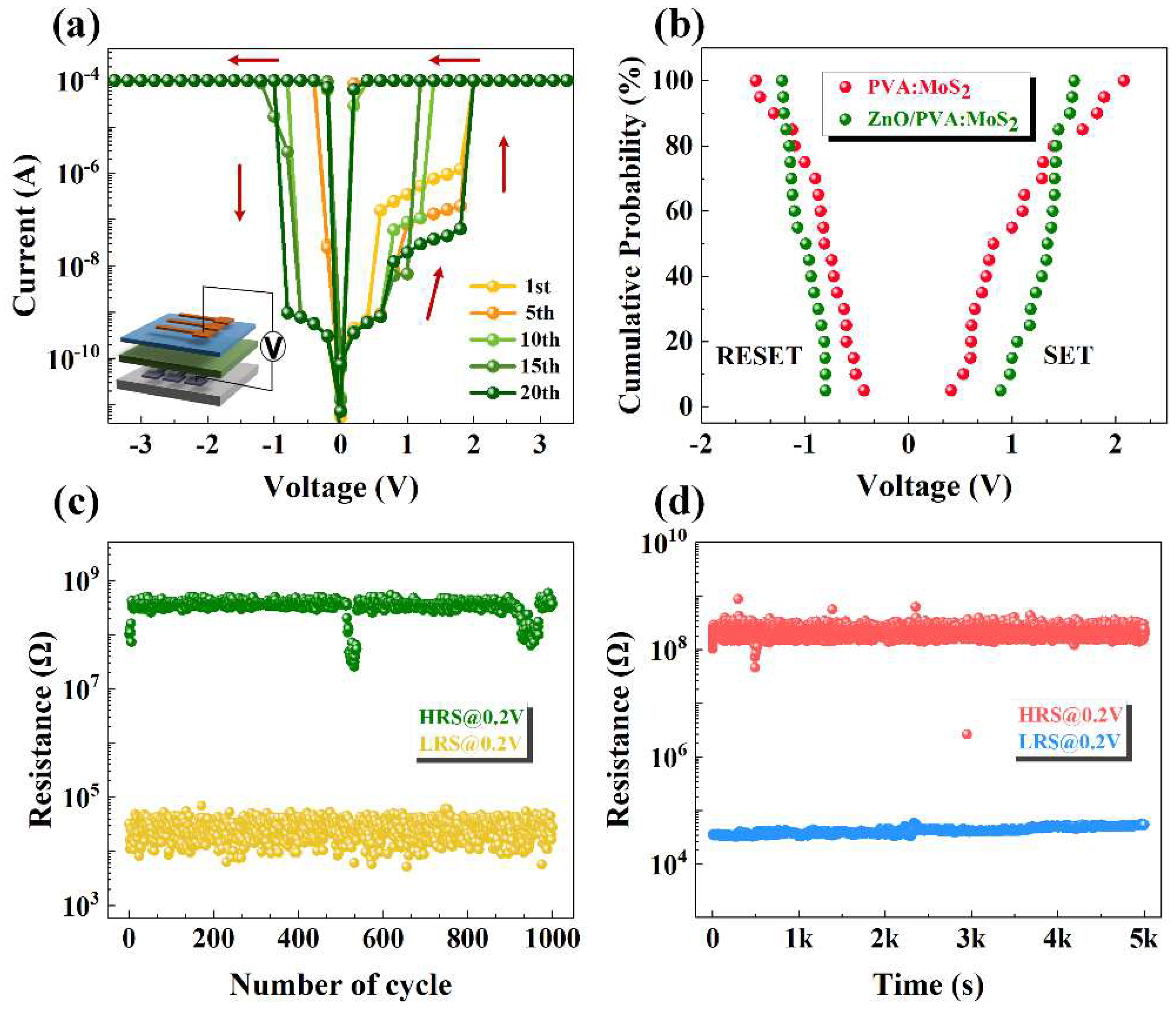Stable Resistive Switching in ZnO/PVA:MoS2 Bilayer Memristor
Abstract
:1. Introduction
2. Experiment
3. Results and Discussion
4. Conclusions
Author Contributions
Funding
Data Availability Statement
Acknowledgments
Conflicts of Interest
References
- Huh, W.; Lee, D.; Lee, C.H. Memristors Based on 2D Materials as an Artificial Synapse for Neuromorphic Electronics. Adv. Mater. 2020, 32, e2002092. [Google Scholar] [CrossRef]
- Yin, S.; Song, C.; Sun, Y.; Qiao, L.; Wang, B.; Sun, Y.; Liu, K.; Pan, F.; Zhang, X. Electric and Light Dual-Gate Tunable MoS2 Memtransistor. ACS Appl. Mater. Interfaces 2019, 11, 43344–43350. [Google Scholar] [CrossRef] [PubMed]
- Yang, Z.; Hong, H.; Liu, F.; Liu, Y.; Su, M.; Huang, H.; Liu, K.; Liang, X.; Yu, W.J.; Vu, Q.A.; et al. High-Performance Photoinduced Memory with Ultrafast Charge Transfer Based on MoS2 /SWCNTs Network Van Der Waals Heterostructure. Small 2019, 15, e1804661. [Google Scholar]
- Shen, Z.; Zhao, C.; Qi, Y.; Xu, W.; Liu, Y.; Mitrovic, I.Z.; Yang, L.; Zhao, C. Advances of RRAM Devices: Resistive Switching Mechanisms, Materials and Bionic Synaptic Application. Nanomaterials 2020, 10, 1437. [Google Scholar] [CrossRef]
- Varun, I.; Bharti, D.; Mahato, A.K.; Raghuwanshi, V.; Tiwari, S.P. High-Performance Flexible Resistive RAM with PVP:GO Composite and Ultrathin HfOx Hybrid Bilayer. IEEE Trans. Electron Devices 2020, 67, 949–954. [Google Scholar] [CrossRef]
- Kim, T.; Kim, D.-K.; Kim, J.; Pak, J.J. Resistive switching behaviour of multi-stacked PVA/graphene oxide + PVA composite/PVA insulating layer-based RRAM devices. Semicond. Sci. Technol. 2019, 34, 65006. [Google Scholar] [CrossRef]
- Jung, K.H.; Yeon, C.; Yang, J.; Cheon, Y.J.; Lim, J.W.; Yun, S.J. Polyvinylalcohol (PVA)-Assisted Exfoliation of ReS2 Nanosheets and the Use of ReS2-PVA Composites for Transparent Memristive Photosynapse Devices. ACS Appl. Mater. Interfaces 2021, 13, 8919–8928. [Google Scholar] [CrossRef]
- Kim, M.; Choi, K.C. Transparent and Flexible Resistive Random Access Memory Based on Al2O3 Film with Multilayer Electrodes. IEEE Trans. Electron Devices 2017, 64, 3508–3510. [Google Scholar] [CrossRef]
- Kumari, A.; Shanbogh, S.M.; Udachyan, I.; Kandaiah, S.; Roy, A.; Varade, V.; Ponnam, A. Interface-Driven Multifunctionality in Two-Dimensional TiO2 Nanosheet/Poly(Dimercaptothiadiazole-Triazine) Hybrid Resistive Random Access Memory Device. ACS Appl. Mater. Interfaces 2020, 12, 56568–56578. [Google Scholar] [CrossRef]
- Bejtka, K.; Milano, G.; Ricciardi, C.; Pirri, C.F.; Porro, S. TEM Nanostructural Investigation of Ag-Conductive Filaments in Polycrystalline ZnO-Based Resistive Switching Devices. ACS Appl. Mater. Interfaces 2020, 12, 29451–29460. [Google Scholar] [CrossRef]
- Khan, S.A.; Lee, G.H.; Mahata, C.; Ismail, M.; Kim, H.; Kim, S. Bipolar and Complementary Resistive Switching Characteristics and Neuromorphic System Simulation in a Pt/ZnO/TiN Synaptic Device. Nanomaterials 2021, 11, 315. [Google Scholar] [CrossRef]
- Lee, J.; Du, C.; Sun, K.; Kioupakis, E.; Lu, W.D. Tuning Ionic Transport in Memristive Devices by Graphene with Engineered Nanopores. ACS Nano 2016, 10, 3571–3579. [Google Scholar] [CrossRef] [PubMed]
- Bhattacharjee, S.; Caruso, E.; McEvoy, N.; Coileáin, C.; O’Neill, K.; Ansari, L.; Duesberg, G.S.; Nagle, R.; Cherkaoui, K.; Gity, F.; et al. Insights into Multilevel Resistive Switching in Monolayer MoS2. ACS Appl. Mater. Interfaces 2020, 12, 6022–6029. [Google Scholar] [CrossRef] [PubMed]
- Wang, X.F.; Tian, H.; Zhao, H.M.; Zhang, T.Y.; Mao, W.Q.; Qiao, Y.C.; Pang, Y.; Li, Y.X.; Yang, Y.; Ren, T.L. Interface Engineering with MoS2-Pd Nanoparticles Hybrid Structure for a Low Voltage Resistive Switching Memory. Small 2018, 14, 1702525. [Google Scholar] [CrossRef]
- Ge, R.; Wu, X.; Kim, M.; Shi, J.; Sonde, S.; Tao, L.; Zhang, Y.; Lee, J.C.; Akinwande, D. Atomristor: Nonvolatile Resistance Switching in Atomic Sheets of Transition Metal Dichalcogenides. Nano Lett. 2018, 18, 434–441. [Google Scholar] [CrossRef]
- Zhuang, P.; Lin, W.; Ahn, J.; Catalano, M.; Chou, H.; Roy, A.; Quevedo-Lopez, M.; Colombo, L.; Cai, W.; Banerjee, S.K. Nonpolar Resistive Switching of Multilayer-hBN-Based Memories. Adv. Electron. Mater. 2019, 6, 1900979. [Google Scholar] [CrossRef]
- Liu, J.; Yang, F.; Cao, L.; Li, B.; Yuan, K.; Lei, S.; Hu, W. A Robust Nonvolatile Resistive Memory Device Based on a Freestanding Ultrathin 2D Imine Polymer Film. Adv. Mater. 2019, 31, e1902264. [Google Scholar] [CrossRef]
- Irshad, M.S.; Abbas, A.; Qazi, H.H.; Aziz, M.H.; Shah, M.; Ahmed, A.; Idrees, M. Role of point defects in hybrid phase TiO2 for resistive random-access memory (RRAM). Mater. Res. Express 2019, 6, 076311. [Google Scholar] [CrossRef]
- Chai, J.; Tong, S.; Li, C.; Manzano, C.; Li, B.; Liu, Y.; Lin, M.; Wong, L.; Cheng, J.; Wu, J.; et al. MoS2/Polymer Heterostructures Enabling Stable Resistive Switching and Multistate Randomness. Adv. Mater. 2020, 32, 2002704. [Google Scholar] [CrossRef]
- Liu, H.-C.; Tang, X.-G.; Liu, Q.-X.; Jiang, Y.-P.; Li, W.-H.; Guo, X.-B.; Tang, Z.-H. Bipolar resistive switching behavior and conduction mechanisms of composite nanostructured TiO2/ZrO2 thin film. Ceram. Int. 2020, 46, 21196–21201. [Google Scholar] [CrossRef]
- Zhuang, P.; Ma, W.; Liu, J.; Cai, W.; Lin, W. Progressive RESET induced by Joule heating in h-BN RRAMs. Appl. Phys. Lett. 2021, 118, 143101. [Google Scholar] [CrossRef]
- Quynh, N.P.L.P.; Thi, T.U.D.; Tran, K.M.; Vu, H.N.; Ta, H.K.T.; Tran, C.V.; Phan, T.B.; Pham, N.K. Improving memory performance of PVA:ZnO nanocomposite: The experimental and theoretical approaches. Appl. Surf. Sci. 2021, 537, 148000. [Google Scholar] [CrossRef]
- Lodhi, A.; Saini, S.; Dwivedi, A.; Khandelwal, A.; Tiwari, S.P. Bipolar resistive switching properties of TiO(x)/graphene oxide doped PVP based bilayer ReRAM. J. Micromechanics Microengineering 2022, 32, 044001. [Google Scholar] [CrossRef]
- Lv, W.; Wang, H.; Jia, L.; Tang, X.; Lin, C.; Yuwen, L.; Wang, L.; Huang, W.; Chen, R. Tunable Nonvolatile Memory Behaviors of PCBM-MoS2 2D Nanocomposites through Surface Deposition Ratio Control. ACS Appl. Mater. Interfaces 2018, 10, 6552–6559. [Google Scholar] [CrossRef] [PubMed]
- Liao, Q.; Wang, Y.; Lv, Z.; Xiong, Z.; Chen, J.; Wang, G.P.; Han, S.-T.; Zhou, Y. Electronic synapses mimicked in bilayer organic-inorganic heterojunction based memristor. Org. Electron. 2021, 90, 106062. [Google Scholar] [CrossRef]
- Xu, N.; Liu, L.F.; Sun, X.; Liu, X.Y.; Han, D.D.; Wang, Y.; Han, R.Q.; Kang, J.F.; Yu, B. Characteristics and mechanism of conduction/set process in TiN/ZnO/Pt resistance switching random-access memories. Appl. Phys. Lett. 2008, 92, 232112. [Google Scholar] [CrossRef]
- Ismail, M.; Rahmani, M.K.; Khan, S.A.; Choi, J.; Hussain, F.; Batool, Z.; Rana, A.M.; Lee, J.; Cho, H.; Kim, S. Effects of Gibbs free energy difference and oxygen vacancies distribution in a bilayer ZnO/ZrO2 structure for applications to bipolar resistive switching. Appl. Surf. Sci. 2019, 498, 143833. [Google Scholar] [CrossRef]
- Bhattacharjee, S.; Sarkar, P.K.; Prajapat, M.; Roy, A. Electrical reliability, multilevel data storage and mechanical stability of MoS2-PMMA nanocomposite-based non-volatile memory device. J. Phys. D Appl. Phys. 2017, 50, 265103. [Google Scholar] [CrossRef]
- Liu, J.; Zeng, Z.; Cao, X.; Lu, G.; Wang, L.-H.; Fan, Q.-L.; Huang, W.; Zhang, H. Preparation of MoS2-Polyvinylpyrrolidone Nanocomposites for Flexible Nonvolatile Rewritable Memory Devices with Reduced Graphene Oxide Electrodes. Small 2012, 8, 3517–3522. [Google Scholar] [CrossRef] [PubMed]
- Chen, J.; Li, Y.; Zhang, Y.; Zhu, Y. Preparation and characterization of graphene oxide reinforced PVA film with boric acid as crosslinker. J. Appl. Polym. Sci. 2015, 132, 42000. [Google Scholar] [CrossRef]
- Sharma, S.K.; Prakash, J.; Pujari, P.K. Effects of the molecular level dispersion of graphene oxide on the free volume characteristics of poly(vinyl alcohol) and its impact on the thermal and mechanical properties of their nanocomposites. Phys. Chem. Chem. Phys. 2015, 17, 29201–29209. [Google Scholar] [CrossRef] [PubMed]
- Chen, Y.T.; Yan, Y.; Wu, J.W.; Wang, C.; Lin, J.Y.; Zhao, J.S.; Hwang, C.S. Electroforming-Free, Flexible, and Reliable Resistive Random-Access Memory Based on an Ultrathin TaOx Film. Acs Appl. Mater. Interfaces 2020, 12, 10681–10688. [Google Scholar] [CrossRef] [PubMed]
- Verbakel, F.; Meskers, S.C.J.; Janssen, R.A.J.; Gomes, H.L.; Coelle, M.; Buechel, M.; de Leeuw, D.M. Reproducible resistive switching in nonvolatile organic memories. Appl. Phys. Lett. 2007, 91, 192103. [Google Scholar] [CrossRef] [Green Version]
- Varun, I.; Mahato, A.K.; Raghuwanshi, V.; Tiwari, S.P. Ultralow Current Switching in Flexible Hybrid PVP:MoS2/HfOx Bilayer Devices. IEEE Trans. Electron Devices 2020, 67, 3472–3477. [Google Scholar] [CrossRef]
- Lee, W.; Kim, Y.; Song, Y.; Cho, K.; Yoo, D.; Ahn, H.; Kang, K.; Lee, T. Investigation of Time-Dependent Resistive Switching Behaviors of Unipolar Nonvolatile Organic Memory Devices. Adv. Funct. Mater. 2018, 28, 1801162. [Google Scholar] [CrossRef]
- Waser, R.; Dittmann, R.; Staikov, G.; Szot, K. Redox-Based Resistive Switching Memories-Nanoionic Mechanisms, Prospects, and Challenges. Adv. Mater. 2009, 21, 2632. [Google Scholar] [CrossRef]
- Wright, G.T. Mechanisms of space-charge-limited current in solids. Solid State Electron. 1961, 2, 165–189. [Google Scholar] [CrossRef]
- Chiu, F.-C. A Review on Conduction Mechanisms in Dielectric Films. Adv. Mater. Sci. Eng. 2014, 2014, 578168. [Google Scholar] [CrossRef] [Green Version]
- Hmar, J.J.L. Flexible resistive switching bistable memory devices using ZnO nanoparticles embedded in polyvinyl alcohol (PVA) matrix and poly(3,4-ethylenedioxythiophene) polystyrene sulfonate (PEDOT:PSS). RSC Adv. 2018, 8, 20423–20433. [Google Scholar] [CrossRef] [Green Version]
- Wu, L.; Guo, J.; Zhong, W.; Zhang, W.; Kang, X.; Chen, W.; Du, Y. Flexible, multilevel, and low-operating-voltage resistive memory based on MoS2-rGO hybrid. Appl. Surf. Sci. 2019, 463, 947–952. [Google Scholar] [CrossRef]
- Woo, M.H.; Jang, B.C.; Choi, J.; Lee, K.J.; Shin, G.H.; Seong, H.; Im, S.G.; Choi, S.-Y. Low-Power Nonvolatile Charge Storage Memory Based on MoS2 and an Ultrathin Polymer Tunneling Dielectric. Adv. Funct. Mater. 2017, 27, 1703545. [Google Scholar] [CrossRef]
- Wang, D.; Ji, F.; Chen, X.; Li, Y.; Ding, B.; Zhang, Y. Quantum conductance in MoS2 quantum dots-based nonvolatile resistive memory device. Appl. Phys. Lett. 2017, 110, 093501. [Google Scholar] [CrossRef]
- Meng, L.; Lan, M.; Guo, L.; Xie, L.; Wang, H.; Ge, J.; Liu, W.; Wang, Y.; Wang, P. Nonvolatile memory devices based on carbon nano-dot doped poly(vinyl alcohol) composites with low operation voltage and high ON/OFF ratio. RSC Adv. 2015, 5, 26886–26890. [Google Scholar] [CrossRef]
- Zhang, P.; Gao, C.; Xu, B.; Qi, L.; Jiang, C.; Gao, M.; Xue, D. Structural Phase Transition Effect on Resistive Switching Behavior of MoS2-Polyvinylpyrrolidone Nanocomposites Films for Flexible Memory Devices. Small 2016, 12, 2077–2084. [Google Scholar] [CrossRef] [PubMed]
- Rehman, M.M.; Siddiqui, G.U.; Gul, J.Z.; Kim, S.W.; Lim, J.H.; Choi, K.H. Resistive Switching in All-Printed, Flexible and Hybrid MoS2-PVA Nanocomposite based Memristive Device Fabricated by Reverse Offset. Sci. Rep. 2016, 6, 36195. [Google Scholar] [CrossRef] [PubMed] [Green Version]
- Patil, H.; Kim, H.; Rehman, S.; Kadam, K.D.; Aziz, J.; Khan, M.F.; Kim, D.K. Stable and Multilevel Data Storage Resistive Switching of Organic Bulk Heterojunction. Nanomaterials 2021, 11, 359. [Google Scholar] [CrossRef] [PubMed]




| Structure | Deposition Technique | ON/OFF Ratio | Endurance Cycles | Retention Time(s) | Year | Ref. |
|---|---|---|---|---|---|---|
| Ag/TiO2/FTO | Hydrothermal method | ~10× | 16 | - | 2019 | [18] |
| Ag/MoS2/PMMA/SiO2 | Sputtering | 104 | 300 | 103 | 2020 | [19] |
| Ag/ZnO/FTO | CVD | >50 | ~40 | >103 | 2020 | [10] |
| Au/TiO2/ZrO2/ITO | Spin coating | 102 | 100 | - | 2020 | [20] |
| Ti/h-BN/Au | CVD | - | 120 | 103 | 2021 | [21] |
| Ag/PVA:ZnO/FTO | Spin coating | ~103 | - | - | 2021 | [22] |
| Ag/GO:PVP/TiOx/ITO | ALD, Spin coating | >103 | 128 | >7 × 103 | 2022 | [23] |
| Ag/ZnO/PVA:MoS2/ITO | Sputtering, Spin coating | ~104 | >1000 | >5 × 103 | - | This work |
Publisher’s Note: MDPI stays neutral with regard to jurisdictional claims in published maps and institutional affiliations. |
© 2022 by the authors. Licensee MDPI, Basel, Switzerland. This article is an open access article distributed under the terms and conditions of the Creative Commons Attribution (CC BY) license (https://creativecommons.org/licenses/by/4.0/).
Share and Cite
Sun, T.; Shi, H.; Gao, S.; Zhou, Z.; Yu, Z.; Guo, W.; Li, H.; Zhang, F.; Xu, Z.; Zhang, X. Stable Resistive Switching in ZnO/PVA:MoS2 Bilayer Memristor. Nanomaterials 2022, 12, 1977. https://doi.org/10.3390/nano12121977
Sun T, Shi H, Gao S, Zhou Z, Yu Z, Guo W, Li H, Zhang F, Xu Z, Zhang X. Stable Resistive Switching in ZnO/PVA:MoS2 Bilayer Memristor. Nanomaterials. 2022; 12(12):1977. https://doi.org/10.3390/nano12121977
Chicago/Turabian StyleSun, Tangyou, Hui Shi, Shuai Gao, Zhiping Zhou, Zhiqiang Yu, Wenjing Guo, Haiou Li, Fabi Zhang, Zhimou Xu, and Xiaowen Zhang. 2022. "Stable Resistive Switching in ZnO/PVA:MoS2 Bilayer Memristor" Nanomaterials 12, no. 12: 1977. https://doi.org/10.3390/nano12121977
APA StyleSun, T., Shi, H., Gao, S., Zhou, Z., Yu, Z., Guo, W., Li, H., Zhang, F., Xu, Z., & Zhang, X. (2022). Stable Resistive Switching in ZnO/PVA:MoS2 Bilayer Memristor. Nanomaterials, 12(12), 1977. https://doi.org/10.3390/nano12121977






